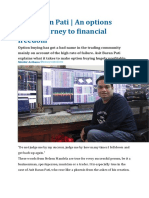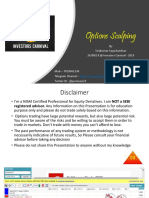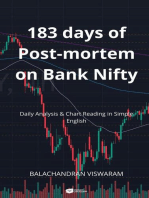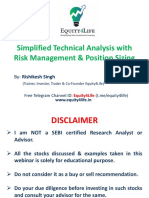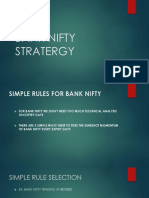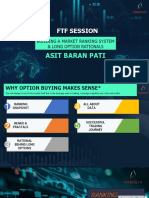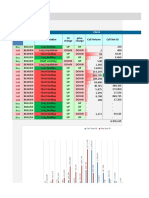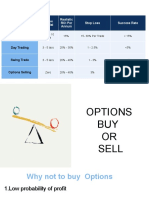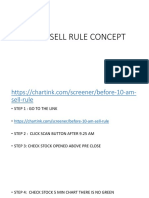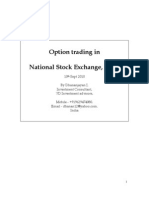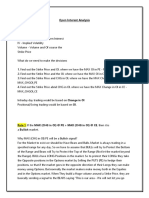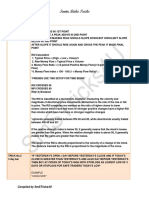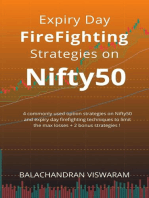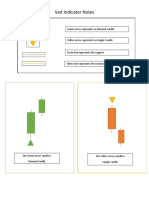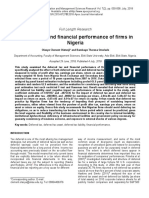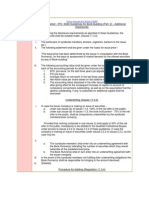VWAP Trading: Trade With Trend
VWAP Trading: Trade With Trend
Uploaded by
Avijit MajumdarCopyright:
Available Formats
VWAP Trading: Trade With Trend
VWAP Trading: Trade With Trend
Uploaded by
Avijit MajumdarOriginal Title
Copyright
Available Formats
Share this document
Did you find this document useful?
Is this content inappropriate?
Copyright:
Available Formats
VWAP Trading: Trade With Trend
VWAP Trading: Trade With Trend
Uploaded by
Avijit MajumdarCopyright:
Available Formats
Trade with Trend
VWAP Trading
Quick Reference Guide
Trade with Trend - YouTube
12-1-2019
Contents
Balance & Imbalance on Charts .............................................................................................................. 2
Best Sectors for VWAP Trading ............................................................................................................... 3
Other Time Frame Traders (Institutional Traders).................................................................................. 4
MSCI Index Links ..................................................................................................................................... 5
Exit for Short Term Trading ..................................................................................................................... 6
Broader Market Trend & Advance Decline ............................................................................................. 8
Exit Rules Checklist.................................................................................................................................. 9
Pattern & VSA Guidelines ..................................................................................................................... 10
Trend Guidelines for Day & Short-term Trading ................................................................................... 11
Pre-Market Open & Day Trading Entry Checklist.................................................................................. 12
Stock Selection & Watch List Guidelines .............................................................................................. 13
Types of Entry ....................................................................................................................................... 14
Risk Management ................................................................................................................................. 15
Open Interest Guidelines ...................................................................................................................... 16
Link to All Videos ................................................................................................................................... 17
Link to Open Interest Data .................................................................................................................... 18
VIX & Guidelines.................................................................................................................................... 19
Disclaimer.............................................................................................................................................. 20
Trade with Trend – YouTube. Copyright 2019. All Rights Reserved.
Balance & Imbalance on Charts
Balance on a chart is a region where Institutional Traders are absent in the market. To know
more about OTF or Institutional Traders, scroll down to Page 5. Balance on chart develops as
Institutional Traders offload their positions. This is the region where maximum weak hands are
present in the market and most of the participation here will be of Retail Traders & Small
Trading prop desks. Price is range bound during such phases and Trending moves are
completely absent. One of the main reasons why Retail Traders fail in Day & Short-Term
trading is because they participate the most in Balance regions.
Imbalance on chart occurs when Institutional Traders enter the market and drive price either
lower or higher. As Traders, we need to participate only in Imbalance phase where presence of
such strong traders is clearly evident.
Trade with Trend – YouTube. Copyright 2019. All Rights Reserved.
Best Sectors for VWAP Trading
As Day Traders and Short-Term Traders, we need to be specific about the Sectors we choose.
If you pay close attention to the Trades I put up, about 90% Trades are from Banking &
Financial Sector, Metals, Commodities, Energy & Infrastructure. Remaining 10% Trades are
from Defensives & Technology space.
This is not to say that VWAP Trading does not work on Defensive & Technology Sector. It is
just that there are some sectors which are more prone to Day & Short-term movement and
hence these should be preferred. Even when I researched on U.S. & U.K. markets, my finding
was more or less consistent.
Top Sectors to Focus Upon (In order of preference)
1. Banking & Financial Services
2. Metals, Energy & Commodities
3. Infrastructure & Construction
4. Defensives (Mainly Technology)
For those of you who are in the U.S. or in Europe, you also have the option to Trade ETF’s.
Focus on MSCI ETF’s. These also tend to move a lot over short term. Some of the instruments
(symbols given below) which I would suggest are,
1) SPY
2) AMD
3) NFLX
4) AMZN
5) FB
6) MS
7) TWTR
8) SUNE
9) AAPL
10) DAL
11) TSLA
Trade with Trend – YouTube. Copyright 2019. All Rights Reserved.
Other Time Frame Traders (Institutional Traders)
OTF Traders are the Big pocket players in the Market. They are the ones who create Demand
& Supply in the Market and our job is to align in the Direction of Trend set by them.
As Retail participants, we are Small players in the market and our positions have minimum
impact in creating large demand or supply. Therefore, it is much more logical to follow what
Other Time Frame traders are doing.
There are several ways to spot OTF Traders in Market and this is something we have discussed
in depth. If the Term OTF Traders has come up in the video without the detailed section on it,
then for now, just understand that OTF Traders are Institutional Traders who need to be tracked
closely.
One of the easiest ways to spot OTF Traders is to look for charts which are Out of Balance and
then look at corresponding volume activity.
Trade with Trend – YouTube. Copyright 2019. All Rights Reserved.
MSCI Index Links
MSCI India Index
https://www.msci.com/documents/10199/1ad792ce-3199-445c-8be3-f2a035ac782d
MSCI India Small Cap Index
https://www.msci.com/documents/10199/fdcc71dd-80ee-42af-a470-b2b67db67530
MSCI India Mid Cap Index
https://www.msci.com/documents/10199/486de8eb-4276-4d92-81e1-31efa6d4a80e
MSCI Mid Cap USA
https://www.msci.com/documents/10199/50394da9-6362-4580-bae3-5b5cb512350c
MSCI Small Cap USA
https://www.msci.com/documents/10199/8038650a-0e6f-43d5-bdb0-1f8f3063e565
MSCI Large Cap USA
https://www.msci.com/documents/10199/40770696-16c0-4b70-89f6-9a8496722fa7
Trade with Trend – YouTube. Copyright 2019. All Rights Reserved.
Exit for Short Term Trading
Exit in short term trading is not at all complicated. In Day trading, based on Momentum we
decide to exit at 1-1.5% fixed gain or at 2-2.5%. It all depends on the underlying conditions of
the market. Exit rules for Day Trading are covered in a separate section and refer to the Index
of this PDF document to revisit the rules.
For Short term trading, you only have to follow structure of higher high and higher low to exit
the Trade. What I generally do is, I exit 50% positions between 5-6% and then for remaining
50% positions, I simply use a structure of higher high and higher low.
Refer to the Two charts in this section and this should be clear to you.
Trade with Trend – YouTube. Copyright 2019. All Rights Reserved.
Trade with Trend – YouTube. Copyright 2019. All Rights Reserved.
Broader Market Trend & Advance Decline
Many Traders don’t realize the Importance of Broader market in Day Trading & Short – Term
Trading. In Day Trading at least, I would define Broader market trend with help of Advance
Decline data.
In my experience, I have found Advance decline reading below 0.7 to be the most optimum for
Short sell trades. For Long trades, Advance decline reading above 1.5 is positive. If you get
Advance decline reading of 3 or 4 in the morning session, then let the market settle. Do not
rush into taking Trades.
In most case, 80% of Day trading move is already over in the first 30 minutes of Trading. This
is precisely why you need to wait out and Enter when you have more information and you have
substantial amount of time left in the market for the session to end.
Trade with Trend – YouTube. Copyright 2019. All Rights Reserved.
Exit Rules Checklist
1. After Entry, Lack of Momentum – After you take entry in the Stock, you need to assess
the underlying momentum in terms of number of Wide range candles that form post Entry. If
you cannot spot Wide range candles for 30-40 minutes, then prepare for a Fixed percentage
exit of 1- 1.5%. On such day’s Advance decline ratio is somewhere between 0.9 – 1.3.
Do calculate R2 & R3 (Standard Pivot Points) once you enter and see If your Fixed percentage
exit coincides with R2.
2. After Entry, Strong Momentum – After you take entry, if you spot wide range candles on
the chart, then be prepared to exit 50% positions at 2% and hold the remaining for end of the
day. On such days, if Advance decline ratio is above 2, then odds are high for you to get 2% or
higher.
Calculate R2 & R3 after you take entry. On Strong momentum days, Price easily crosses R2
and moves towards R3 and beyond.
Kindly note, S1, S2, S3 & R1, R2, R3 are standard Pivot points and calculation of these was
shown in the Intraday Trading playlist.
After you take entry, calculate what is 1%, 1.5% & 2% from your Entry point. If possible, mark
these on the chart.
Trade with Trend – YouTube. Copyright 2019. All Rights Reserved.
Pattern & VSA Guidelines
Let me just summarize the most Important guidelines of Patterns & VSA. Revise these daily
before market opens.
1) Close of the Candle is extremely important.
2) Candle should be wide in range and,
3) Volume expansion should be visible.
4) Long wick with High volume denotes supply in Market,
5) Long tail and High volume denote demand in Market.
6) Wide range candle with Strong close and high volume is sign of Strength Candle.
7) Strength candle is vital in Entry & Exit.
8) Narrow range candles with high volume are Reversal candles.
Trade with Trend – YouTube. Copyright 2019. All Rights Reserved.
Trend Guidelines for Day & Short-term Trading
1. Always align with Stronger players in the market.
2. For trend reference, focus on Daily time frame.
3. Use 50 Day moving average to identify bias of Trend.
4. Look for Price being above or below 50 Day moving average.
5. Apart from these, do not forget importance of Slope of moving average.
Trade with Trend – YouTube. Copyright 2019. All Rights Reserved.
Pre-Market Open & Day Trading Entry Checklist
1. Check for Trend of S&P 500, Nikkei & DAX.
2. Check for which sectors are performing well in Pre-Market open.
3. If most high beta sectors perform well, take note of same.
4. Check for trend of Volatility Index.
5. Avoid taking simultaneous position in High beta & Defensive sectors.
6. For Day Trading entry,
a. Check for Trend of Stock
b. Check for VWAP Structure
c. Check for Volume Profile Criteria
d. Volume expansion should be visible
e. Wide Range candle should also be visible
f. Balance on chart (Most crucial)
7. For Short Term Trading,
a. Check for Trend of Stock
b. Check for Volume Profile condition
c. Balance on chart should be visible
d. Check for Volume expansion
e. Check for Wide range candle
f. No near-term Resistance levels
Trade with Trend – YouTube. Copyright 2019. All Rights Reserved.
Stock Selection & Watch List Guidelines
1. Focus on Stocks where Institutional Traders are active. This should form your watchlist.
2. Focus on having no more than 30 Stocks in Watchlist. Follow steps shown in the
Training.
3. Watchlist of 30 Stocks to be revised once in 6 months. Remember, consistency is the
key here.
4. Stocks which are Out of Balance should be selected,
5. Along with this, all conditions of VWAP Structure & Trend should be fulfilled.
6. Avoid Stocks that show too much deviation away from VWAP Structure.
7. Prefer Stocks within the Volume profile region.
8. Only those Stocks to be selected which qualify for Short term trades.
Trade with Trend – YouTube. Copyright 2019. All Rights Reserved.
Types of Entry
1. Morning Entry is the Riskiest. Stay away from this for at least 6 Months.
2. Focus on Morning Retracement & Morning Breakout.
3. Out of these, Morning Breakout is the easiest to Trade.
4. Afternoon Trades to be taken before 2:45 Pm.
5. Only exception of Afternoon time is if it is Expiry session.
6. Do not Trade gaps for the first 6 months. Experience is Important.
7. If you want to Trade gaps in future, then prefer entering with Morning Retracement.
Trade with Trend – YouTube. Copyright 2019. All Rights Reserved.
Risk Management
1. Prefer Equities. This will save you a lot of Money in the end.
2. Equities offer tremendous amount of flexibility.
3. Avoid scaling in with this method.
4. Follow Risk stages that I have shown. This is important. Think Risk first.
5. To Calculate Position Size,
a. Identify Entry Level
b. Identify Stop Loss Level
c. Define Risk Per Trade
d. Position Size = (Risk Per Trade) / (Difference of Entry & Stop Loss)
6. Do not venture into F&O.
Trade with Trend – YouTube. Copyright 2019. All Rights Reserved.
Open Interest Guidelines
1. Identify Stock based on all the Rules discussed.
2. Before entering the Stock, check for Net Open Interest one day prior to Current date.
3. Make sure you check for Net Open Interest of entire Option chain.
4. Clearly mark out Resistance level in terms of Open Interest addition at Call Strike Price.
5. Prefer only those stocks where Open Interest (Resistance) is not spread across all strike
prices.
6. If you have 2-4 Stocks you want to Trade, prefer the one with least Open Interest
resistance.
7. If the Stock you select has significant overhead Resistance in terms of Open Interest,
then reduce Risk per trade amount by Half.
Trade with Trend – YouTube. Copyright 2019. All Rights Reserved.
Link to All Videos
Following are all resources available on Trade with Trend YouTube Channel.
1. Intraday Trading - https://bit.ly/2oDtH08
2. Swing Trading - https://bit.ly/2JY4SDR
3. Heiken Ashi - https://bit.ly/2NFgzAm
4. Options Trading - https://bit.ly/2qebBlR
5. Market Profile - https://bit.ly/2r4q58h
6. Futures Trading - https://bit.ly/2N8qijg
7. Ichimoku - https://bit.ly/2r1WNqQ
8. Stock Picking - https://bit.ly/36nUmPz
Trade with Trend – YouTube. Copyright 2019. All Rights Reserved.
Link to Open Interest Data
I refer to Sensibull Trading platform for Open Interest data. Trade with Trend has no
commercial affiliation with this website. Link to Sensibull website is given below,
https://web.sensibull.com
Trade with Trend – YouTube. Copyright 2019. All Rights Reserved.
VIX & Guidelines
1. Volatility Index is Important for Day Trading
2. When Volatility is high, prefer Low Beta & Defensive sectors.
3. When Volatility is low, prefer High Beta sectors.
4. If possible, keep an eye on Chart of Volatility Index. This will help.
5. For those in the U.S., prefer tracking CBOE Volatility or Nasdaq Vol Index.
More updates for each Section will be given In VWAP Trading Club section.
Trade with Trend – YouTube. Copyright 2019. All Rights Reserved.
Disclaimer
TradingWithTrend.Com and Trade With Trend YouTube Channel is in compliance with SEBI’s
Research Analyst 2014 regulation. SEBI has asked individual analysts to register with SEBI before
making recommendations or expressing views on securities or public offer. However, SEBI has allowed
comments on general trends in Security markets, discussion on broad-based Indices, commentaries on
Economic, Political and General market condition and Technical Analysis relating to demand and
supply in a Sector or an Index. At TradingWithTrend.Com and Trade With Trend YouTube
Channel w.e.f 1st December 2014, all posts will be made in compliance with new regulation of SEBI.
No Author at TradingWithTrend.Com and Trade With Trend YouTube Channel is registered with
SEBI or any regulating authority as a Research Analyst or an Investment Adviser. Please Consult Your
Investment Adviser before making any Investment/Trading decisions based on content posted in this
Website and In Online & Offline Training. All information posted in this website and our Online/offline
Training is for educational purpose only.
All information on TradingWithTrend.Com and Trade With Trend YouTube Channel is subject
to change without prior notice and, although we strive for accuracy, errors and omissions may occur.
Information is updated as quickly as possible as to maximize the reliability of such information. All
content including but not limited to market analyses, external links, author posts, Trainings and visitor
comments published on TradingWithTrend.Com and Trade With Trend YouTube Channel should
not be taken as investment advice. All information that we post
on TradingWithTrend.Com and Trade With Trend YouTube Channel is strictly for informational
and educational purposes. Comments left on our website by visitors do not necessarily
represent TradingWithTrend.Com views or opinions. All information contained on this website is
provided as general information only, and does not constitute financial advice.
Anything written here should be subject to independent verification! There is no guarantee of the
accuracy or timeliness of the information put forth on this website, and no warranty is implied or
expressed. There shall not be any liability for losses or damages incurred in connection with this
website. In no way shall TradingWithTrend.Com And Trade With Trend YouTube Channel or its
associates or partners be liable for any damage/loss whatsoever.
By visiting this Website And Our YouTube Channel, you automatically adhere to have read this
Disclaimer notice.
Trading & Investing in Futures & Options carries substantial risk and hence we do not recommend any
beginner to participate in these segments. Please consult your Financial Advisor.
Trade with Trend – YouTube. Copyright 2019. All Rights Reserved.
Trade with Trend – YouTube. Copyright 2019. All Rights Reserved.
You might also like
- Fintree Juices Notes 2024Document308 pagesFintree Juices Notes 2024Prachi GoyalNo ratings yet
- How To Be A Successful Scalper Using OI PulseDocument205 pagesHow To Be A Successful Scalper Using OI Pulsevvpvarun100% (10)
- FULL Download Ebook PDF Fundamentals of Healthcare Finance Second Edition PDF EbookDocument41 pagesFULL Download Ebook PDF Fundamentals of Healthcare Finance Second Edition PDF Ebookjennifer.lawver532100% (46)
- Option Buying Asit Baran PatiDocument10 pagesOption Buying Asit Baran PatiRam Varma67% (3)
- Oi Pulse Full CourseDocument224 pagesOi Pulse Full Courserahul.drk100% (2)
- Option Buying FinalDocument59 pagesOption Buying Finalhardik Patel100% (4)
- Options Scalping Refresher DocumentDocument25 pagesOptions Scalping Refresher DocumentChandrasekar Chandramohan96% (24)
- 436687537-Option-Scalping Sivakumar Jayachandran PDFDocument15 pages436687537-Option-Scalping Sivakumar Jayachandran PDFdcs50% (2)
- WEBINAR PPT - Decmber 15Document141 pagesWEBINAR PPT - Decmber 15fixemi100% (14)
- Promodh Kumar OPTION Trading ASTrageyDocument4 pagesPromodh Kumar OPTION Trading ASTrageyRajesh Kumar100% (1)
- 15 Strategies For Intra DayDocument4 pages15 Strategies For Intra DayNaruto Shippuden100% (3)
- Index CPR StrategiesDocument93 pagesIndex CPR StrategiesMak N100% (5)
- BTST & STBT Strategy - by Nse & MCX Arena 1Document3 pagesBTST & STBT Strategy - by Nse & MCX Arena 1देवेंद्र विश्राम परब0% (2)
- Trading Nifty Futures For A Living by Chartless Trader Vol Book 1Document3 pagesTrading Nifty Futures For A Living by Chartless Trader Vol Book 1Anantha TheerthanNo ratings yet
- Equity4Life TA RM PS ElearnmarketDocument29 pagesEquity4Life TA RM PS Elearnmarketkmurali100% (1)
- Option Buying SetupDocument17 pagesOption Buying Setuprahul100% (1)
- Trading Stocks Intraday PDFDocument10 pagesTrading Stocks Intraday PDFSwathy Rai0% (1)
- 315 StrategyDocument33 pages315 StrategyRaghav Sampath100% (1)
- Bank Nifty Stratergy PDFDocument11 pagesBank Nifty Stratergy PDFRuhul IslamNo ratings yet
- 01 Screener by KGSDocument11 pages01 Screener by KGSDinesh100% (1)
- Investment Banker Finance Resume TemplateDocument2 pagesInvestment Banker Finance Resume TemplatePho6No ratings yet
- BNF Option Trading On ExpiryDocument35 pagesBNF Option Trading On ExpirySwastik TiwariNo ratings yet
- Professional Day Trading & Technical Analysis Strategic System For Intraday Trading Stocks, Forex & Financial Trading.From EverandProfessional Day Trading & Technical Analysis Strategic System For Intraday Trading Stocks, Forex & Financial Trading.No ratings yet
- How To Be A Successful Option Scalper Using OI PulseDocument223 pagesHow To Be A Successful Option Scalper Using OI PulseVarun Parihari100% (1)
- Option Buying Setup: by - Jitendra JainDocument17 pagesOption Buying Setup: by - Jitendra JainvvpvarunNo ratings yet
- FTF AsitDocument25 pagesFTF Asitratan203100% (3)
- Banknifty IntradayDocument117 pagesBanknifty IntradayUmesh ThakkarNo ratings yet
- BANK NIFTY WEEKLY OPTION STRATEGIES StraDocument20 pagesBANK NIFTY WEEKLY OPTION STRATEGIES Strafrank georgeNo ratings yet
- Nsemcxarena StrategyDocument22 pagesNsemcxarena Strategyदेवेंद्र विश्राम परबNo ratings yet
- Nifty Trading StrategyDocument19 pagesNifty Trading StrategyTopNo ratings yet
- The Best Trading Strategy To Find Nifty and Bank Nifty Direction Before Market OpenDocument3 pagesThe Best Trading Strategy To Find Nifty and Bank Nifty Direction Before Market OpenNifty Trend0% (3)
- Bank Nifty: Daily StrategyDocument25 pagesBank Nifty: Daily StrategySohil ShahNo ratings yet
- Optn StrategyDocument10 pagesOptn StrategyIndraneel BoseNo ratings yet
- Pathik StrategiesDocument6 pagesPathik StrategiesMayuresh DeshpandeNo ratings yet
- Banknifty StrategyDocument35 pagesBanknifty StrategySumeet LudhwaniNo ratings yet
- Options Open Interest AnalysisDocument17 pagesOptions Open Interest Analysisajju13780% (1)
- NiftyBank Intraday Option Buying Single Successull StrategyDocument30 pagesNiftyBank Intraday Option Buying Single Successull Strategyajayvg80% (5)
- NIFTY - Options Open Interest AnalysisDocument22 pagesNIFTY - Options Open Interest AnalysisSamir MatkarNo ratings yet
- Option Selling WorkshopDocument10 pagesOption Selling Workshopchethan626100% (1)
- 11.BTST Trading StrategyDocument15 pages11.BTST Trading Strategyrocimo100% (1)
- VijaySir's - Learn - How - To - Fish PDFDocument88 pagesVijaySir's - Learn - How - To - Fish PDFANo ratings yet
- UntitledDocument19 pagesUntitledDeepak Raj100% (1)
- eLearnMarkets OptionsBuying HindiDocument17 pageseLearnMarkets OptionsBuying Hindisrinivas250% (2)
- Before 10 Am Sell SureshotDocument9 pagesBefore 10 Am Sell SureshotSujit Soni50% (2)
- 5 6167880689858379820Document31 pages5 6167880689858379820Siva Prakash50% (2)
- Price Action & RM-PS Spider PDFDocument28 pagesPrice Action & RM-PS Spider PDFGenrl Use100% (1)
- Intraday GVK StocksDocument9 pagesIntraday GVK Stockssri sriNo ratings yet
- MentoringDocument24 pagesMentoringVarun Vasurendran100% (1)
- Option BuyingDocument14 pagesOption BuyingLuke Whiteman67% (3)
- Banknifty 15 Min StrategyDocument4 pagesBanknifty 15 Min StrategyshardulenggNo ratings yet
- Data Trading Nifty StrategyDocument35 pagesData Trading Nifty StrategySharma comp100% (1)
- Option Trading Strategy in NIFTY, IndiaDocument16 pagesOption Trading Strategy in NIFTY, Indiadhanan1267% (3)
- CRUDEOIL INTRADAY STRATEGY - Swapnaja SharmaDocument268 pagesCRUDEOIL INTRADAY STRATEGY - Swapnaja Sharmaআম্লান দত্ত0% (1)
- Hilega Milega ConceptsDocument8 pagesHilega Milega ConceptsManan AgarwalNo ratings yet
- Trading A Stock and Trading A INDEXDocument49 pagesTrading A Stock and Trading A INDEXPARTH DHULAMNo ratings yet
- Nifty Intra Day TradingDocument20 pagesNifty Intra Day Tradingvarun vasurendran100% (1)
- OI - Understanding Option Chain ExcelDocument4 pagesOI - Understanding Option Chain Excelsripeksha123No ratings yet
- 27 Aug Risk Management Theory NotesDocument5 pages27 Aug Risk Management Theory NotesChitranjan SharmaNo ratings yet
- Tutorial SantuBabaTricksDocument64 pagesTutorial SantuBabaTricksArvsrv100% (14)
- Fa1 Mock 3Document9 pagesFa1 Mock 3smartlearning1977100% (1)
- Additional Financial Reporting Issues: Chapter OutlineDocument26 pagesAdditional Financial Reporting Issues: Chapter OutlineFernando III PerezNo ratings yet
- FinRep SummaryDocument36 pagesFinRep SummaryNikolaNo ratings yet
- Various Sources of Quali-ReviewDocument20 pagesVarious Sources of Quali-ReviewrjragsagNo ratings yet
- Best Options Trading Alert ServiceDocument19 pagesBest Options Trading Alert ServiceMr Phil NewtonNo ratings yet
- Module 10 Financial StatementsDocument17 pagesModule 10 Financial StatementsChristine CariñoNo ratings yet
- Bambang S (1406512732) - Capital Structure and The COC (Theory and Evidence)Document25 pagesBambang S (1406512732) - Capital Structure and The COC (Theory and Evidence)Bambang SutrisnoNo ratings yet
- Evaluation of Foreign ProjectsDocument18 pagesEvaluation of Foreign ProjectsMJ jNo ratings yet
- Hyundai Motor Company Annual 2022 Consolidated FinalDocument92 pagesHyundai Motor Company Annual 2022 Consolidated Finalsreejithbhasi128No ratings yet
- Context - ZerodhaDocument2 pagesContext - ZerodhaParam ShahNo ratings yet
- Ved IndicatorDocument13 pagesVed Indicatorleninkumar2020No ratings yet
- ViTrox 20230728 HLIBDocument4 pagesViTrox 20230728 HLIBkim heeNo ratings yet
- Financial Management - NotesDocument49 pagesFinancial Management - NotesSoniaNo ratings yet
- This Study Resource Was: Profit Loss Profit LossDocument9 pagesThis Study Resource Was: Profit Loss Profit LossrogealynNo ratings yet
- Financial: AnalysisDocument55 pagesFinancial: AnalysisJennelyn MercadoNo ratings yet
- Multibagger Stocks: Zafar Shaikh Founder & CEO INVESYSDocument37 pagesMultibagger Stocks: Zafar Shaikh Founder & CEO INVESYSTrading Cues100% (1)
- Shrieves Casting Company Is Considering Adding A New Line ToDocument3 pagesShrieves Casting Company Is Considering Adding A New Line ToAmit PandeyNo ratings yet
- DeferredTaxAccountingandFinancialPerformance. Olaoye ClementDocument9 pagesDeferredTaxAccountingandFinancialPerformance. Olaoye ClementOlanrewaju JoeNo ratings yet
- p2 Guerrero Ch8 CompressDocument18 pagesp2 Guerrero Ch8 CompressLaiza Grace FabreNo ratings yet
- Interest On DrawingDocument8 pagesInterest On DrawingShubh GargNo ratings yet
- Treynor RatioDocument1 pageTreynor Ratiosana_sr_96No ratings yet
- Kds Accessories Prospectus 20150802 1448969638 614818e00b148Document188 pagesKds Accessories Prospectus 20150802 1448969638 614818e00b148night dreamersNo ratings yet
- RBI ROI FormatDocument11 pagesRBI ROI FormatSandeep SandyNo ratings yet
- Depository System in IndiaDocument19 pagesDepository System in IndiaAlisha GuptaNo ratings yet
- FM I - Chapter Two NoteDocument16 pagesFM I - Chapter Two Notenatnaelsleshi3No ratings yet
- Primary Market - IPO-SEBI Guidelines For Book Building (Part: 2) - Additional DisclosuresDocument4 pagesPrimary Market - IPO-SEBI Guidelines For Book Building (Part: 2) - Additional DisclosuresAshma JainNo ratings yet
- Working Capital RequirementDocument20 pagesWorking Capital RequirementKrishnakant Mishra100% (1)



